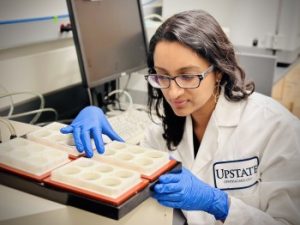Using a grant from the National Eye Institute, an Upstate researcher and ophthalmologist plans to create a new way to test the potential causes of and contributors to glaucoma. Assistant professor Preethi S. Ganapathy, MD, PhD, was awarded $447,000 over two years to develop a model that could help overcome a hurdle researchers face while studying the neurodegenerative disease. Currently, glaucoma affects 3 million Americans, is incurable, and is the second leading cause of blindness worldwide.

“Glaucoma is often associated with high pressure inside of the eye; this pressure causes strain, so it can either compress or pull on the optic nerve and cause damage to the cells in that region,” she explains. “But we don’t know exactly how the strain damages the optic nerve.”
Ganapathy plans to create a 3D model system of human optic nerve head cells to test how this strain impacts the eye. A new way to test the potential causes of glaucoma is needed to overcome current challenges to studying the disease.
“The human optic nerve head has a mix of helper cells that all work together to support the retinal ganglion cells,” says Ganapathy. “But mice don’t have these cells, and it’s really hard to get into the back of the eye and see what’s going on at a molecular level.”
By creating a model system of these helper cells, called glia, Ganapathy proposes that researchers will be able to use cultured cells and apply strain in a way that will mimic the strain seen in human eyes.
Ganapathy plans to use this technique to test the idea that fibrosis, or the hardening/scarring of tissue, is a contributing factor to the development of glaucoma.
“We know that the tissue becomes more fibrotic, stiffer and denser, as we get older. For example, if children develop glaucoma their pressures are often in the 40s, while an 80-year-old may develop glaucoma with a pressure of 16. The idea is that developing fibrosis in the optic nerve head as we get older makes the nerve more susceptible to glaucoma.”
Once the model has been developed, Ganapathy plans to work with Colleen McDowell, PhD, a researcher at the University of Wisconsin-Madison who studies a specific protein, called fibronectin, that promotes fibrosis. “For the second step, we’re going to use this system to see whether this specific protein is making the whole situation worse.”
Ganapathy is excited about studying the impact fibrosis may have on glaucoma.
“It’s funny how things come in and out of vogue in science. Fibrosis has been known and studied for a long time, but we haven’t really looked at it in the optic nerve. Unlike, for example, the brain, which is a soft tissue, the eye has structure. It makes sense that changes in the stiffness could make a difference.”
Working as a clinician and researcher has allowed Ganapathy to see the problem glaucoma presents from the scientist and patient perspectives.
“Glaucoma is a tough condition because it affects vision, sometimes very quickly. I think it’s important to be able to say [to patients] not ‘this is what we’ve been doing’ but ‘this is what’s on the horizon’. It’s a very exciting time, both surgically and scientifically, for glaucoma research and treatment.”
Ganapathy is an investigator at Upstate’s Center for Vision Research; find out more about the center’s work here- https://www.upstate.edu/cvr
